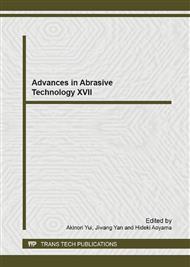p.212
p.218
p.222
p.228
p.237
p.243
p.249
p.255
p.261
Optimizing the Dry Grinding Process on the Basis of Bond Materials
Abstract:
In order to decrease the negative environmental impacts of the cutting fluids (for example, disposal of grinding sludge) and also to reduce the manufacturing costs and the required space for the machines the dry grinding can be a conceivable alternative for the conventional grinding processes. Nevertheless, dry grinding has not been widely introduced into industry because of the high temperature generated in the grinding zone and difficulties of heat transfer without coolants. Selection of the proper grinding wheel bonds, grit sizes and concentration has significant effect on the grinding performance and the generated heat in the contact zone. This paper addresses the effects of the grinding wheel bond and the concentration on the dry grinding process efficiency through comparing the results of the carried out experiments with three resin bonded cBN-cup-wheels, each consisting different bond components. For this purpose, surface roughness and thermal damages during dry and wet grinding (utilizing grinding oil) by three different resin bonds were measured. The results show almost identical surface roughness values for dry and wet grinding. Furthermore, using the resin-kryolith-graphite bonded wheel leads to a reduction in thermal damages on the workpiece. Through different experiments, it was shown that the different bonds, used in this study, have significant influence on the chip loading of the grinding wheels. This is contributed to the different chip formation mechanisms and induced grinding temperatures when grinding by the different wheel bonds.
Info:
Periodical:
Pages:
237-242
Citation:
Online since:
September 2014
Authors:
Keywords:
Price:
Сopyright:
© 2014 Trans Tech Publications Ltd. All Rights Reserved
Share:
Citation:


